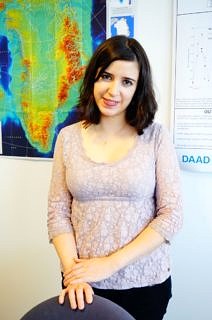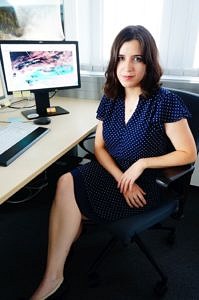Marta Caballero

PhD student at the Institute for Geography and DAAD scholar
Marta Caballero was born in Santiago de Chile, Chile. Until 2012, she studied Physics Engineering at the University of Santiago, Chile (Universidad de Santiago de Chile, USACH) where she specialised on environmental and air quality measurements. Therefore, during her early years, she worked on air quality studies at USACH and the Chilean Centro Mario Molina.
In 2014, Marta Caballero started to work as head of the Laboratory of Radiometry and Photometry at the Physics Department of USACH where she was in charge of the calibration of radiometric sources and spectroradiometers. This work was focused on albedo measurements in Antarctica and characterization of the solar spectrum in the Northern Chile. In between, from January until March 2013, she worked at the University of Chicago on supraglacial hydrology on floating ice shelves.
In March 2016, Marta Caballero was awarded a DAAD (Deutscher Akademischer Austauschdienst, German Academic Exchange Service) scholarship for doctoral research for her PhD project “Role of the clouds on the Energy Balance on the Antarctic Peninsula Ice Sheet” at the Institute for Geography at FAU.
FAU, in the field of Geography, especially in Glaciology and Remote Sensing, is well known in South America because of the collaboration between Chile, Argentina and Ecuador and because of various publications.
What is your field of research and what initially sparked your interest in this field?
My research field is the remote sensing of clouds on the Antarctic Peninsula. I study satellite derived cloud properties with radiosonde data collected at two stations: Escudero and O’Higgins, which are both Chileans.
My interest in this field started with a high interest in learning more about the remote sensing techniques. I considered that it is an unusual way, or romanticized way, to measure the Earth surfaces without touching them. Following this motivation, I did a course for two years about satellite image processing and analysis for physics engineering students at the University of Santiago De Chile (USACH) before coming to FAU; and I was also in charge of the Laboratory of Radiometry and Photometry, in the Physics Department at the same University.
Why did you decide to do doctoral research at FAU?
I decided to do my doctoral research at FAU because I received some recommendations from other colleagues in Chile; there are ongoing collaborations between FAU, Chile and Argentina. Also, I investigated the research topics of the remote sensing group of the Institute of Geography, and I realized that they fit with my research interests.
Can you shortly describe what your Phd is about?
My PhD has the following question to solve: How do clouds, through their radiative properties – they reflect the incoming solar radiation back to space and they do a greenhouse effect – play a role on the energy balance in the Antarctic Peninsula? To answer this question, it is necessary to do this evaluation through regional climate models, although modelling is not a topic of my research area. But it is known that there is an inadequate cloud representation in climate models, which can be seen through bias between measured and modelled shortwave and longwave radiation. In order to fill this gap, a long term database of cloud properties is needed. Since ground based observations, that is radiosonde launchings, are challenging due to the remoteness of the area, the long term and global coverage of satellite derived cloud properties data can allow us to fill these gaps. That is the reason why the improvement and validation of satellite cloud data is of high interest to me.
My PhD work is in collaboration with USACH. In late 2017, we made a field campaign at the O’Higgins station on the Antarctic Peninsula, launching radiosondes in order to monitor clouds. We were invited by the USACH Antarctic group.
How visible is FAU in your field of research?
FAU, in the field of Geography, especially in Glaciology and Remote Sensing, is well known in South America because of the collaboration between Chile, Argentina and Ecuador and because of various publications.

Why should international researchers come to FAU?
They should come to FAU first for the worldwide visibility of the University, its reputation in the research field in which the researcher is working. Second, FAU, through its Welcome Centre, offers help at the beginning with the accommodation search, enrolment at the University, and some other important things to start living in Germany. Also, international researchers should not feel isolated during their stay here at FAU: there are a lot of events, seminars and trips for international students arranged by the Welcome Centre, which help to understand and to get involved in the German culture. Besides that, there are other events where researchers can exchange ideas with others; there are courses which researchers can attend and where they can improve their knowledge. Finally, it is important to know that also FAU offers German language courses to students.
Do you have an advice for researchers who think about coming to FAU?
First, they should be aware that coming here means a big life change and challenge, and as it is a challenge, it should not be underestimated; this challenge should be lived and appreciated as a way to open our minds. Second, international researchers should never hesitate to ask, to ask the Welcome Centre, to ask their colleagues, whatever they wonder about life, mental health and formalities here. There is always help if they knock the door.
What makes FAU special to you?
The hospitality. At the beginning, the Welcome Event and the hospitality of the Welcome Centre team, offering help in several issues that must be solved during the early days, made me feel a little bit more at home, since I came here alone.
What do you like most about the Erlangen-Nürnberg region?
I like most the Franconian culture, especially the Brezels and beer. Also the silence that surrounds every place in Erlangen makes me feel comfortable to stay focused on my research work. It is lovely.
Do you have a favourite place at FAU and Erlangen or Nürnberg?
My favourite place is the Schlossgarten. Indeed it is a perfect place to stay hidden alone for a while and read or think, or just walk inside the gardens.
What did you find strange about German culture/the Germans at the beginning?
I found something strange, but beautiful and tasty: Brotzeit! I love to have lunch break with my colleagues, enjoying some fresh baked bread with sauces, cheeses and vegetables. When I went to Chile for fieldwork in the Antarctica last year, and I stayed with my family, I adopted that to our lunch breaks.
Do you have a hobby and/or did you start a new leisure time activity since you came to Erlangen?
Since I came to Erlangen, I returned to my musical side: I play the piano and I have now a keyboard at home. So, during this time here, I play and compose some musical stuff during my free time. It is a beautiful way to join music and science!
Thank you for the interview, Marta.